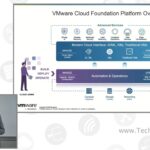|
|

Rick Walsworth presented for VMware by Broadcom at CFD21 |
This video is part of the appearance, “VMware Presents at Cloud Field Day 21“. It was recorded as part of Cloud Field Day 21 at 8:00-11:30 on October 24, 2024.
Watch on YouTube
Watch on Vimeo
This session provides a summary of the VMware Cloud Foundation platform architecture, components and outcomes to build, deploy, operate and consume Private Cloud infrastructure for traditional and modern app workloads. This session will close with a brief overview of the latest VCF 5.2 release.
In this presentation, Rick Walsworth from VMware, now part of Broadcom, provides an overview of VMware Cloud Foundation (VCF) and its evolution since the Broadcom acquisition. He explains how the acquisition has streamlined operations, allowing for faster innovation and a more focused go-to-market strategy. VCF is designed to help organizations build, deploy, and manage private cloud infrastructure using cloud methodologies, while still maintaining the privacy, security, and performance of on-premises systems. Walsworth highlights the challenges customers face when modernizing their infrastructure, particularly when trying to integrate cloud methodologies with traditional three-tier architectures. He notes that many organizations initially view public cloud as a quick solution but often face cost overruns, leading to a trend of repatriating workloads back on-premises. VCF aims to provide a hybrid solution by combining the best of both worlds—on-premises control with cloud-like automation and scalability.
Walsworth also delves into the architecture of VCF, which caters to two main personas: cloud administrators and platform teams. Cloud administrators are provided with tools for capacity management, tenancy management, and fleet management, enabling them to operate infrastructure at scale. Platform teams, on the other hand, focus on delivering infrastructure as a service to developers, often using a combination of traditional VMs and containers orchestrated by Kubernetes. VCF integrates with various advanced services, such as AI workloads, disaster recovery, and security features, which can be added on top of the core platform. The platform also supports automation through infrastructure-as-code methodologies, allowing for seamless integration with DevOps pipelines. Walsworth emphasizes the importance of ongoing education and professional services to help customers fully utilize the platform’s capabilities, especially as they scale and customize their environments.
Personnel: Rick Walsworth









